All the Rock Art in Africa That Is Possible to Find Has Been Found True False

Petroglyph attributed to Classic Vernal Fashion, Fremont archaeological civilisation, eastern Utah, United states

Reclining Buddha at Gal Vihara, Sri Lanka where the remains of the paradigm house that originally enclosed is visible
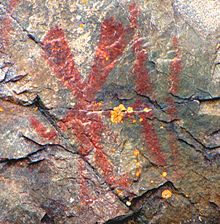
In archaeology, rock fine art is human-made markings placed on natural surfaces, typically vertical stone surfaces. A high proportion of surviving historic and prehistoric rock art is establish in caves or partly enclosed rock shelters; this type also may be chosen cave art or parietal art. A global miracle, rock art is plant in many culturally diverse regions of the world. It has been produced in many contexts throughout human history. In terms of technique, the main groups are: petroglyphs, which are carved or scratched into the rock surface, cave paintings, and sculpted rock reliefs. Another technique creates geoglyphs that are formed on the ground. The oldest known rock fine art dates from the Upper Palaeolithic menses, having been establish in Europe, Commonwealth of australia, Asia, and Africa. Anthropologists studying these artworks believe that they likely had magico-religious significance.
The archaeological sub-discipline of rock art studies kickoff developed in the late-19th century among Francophone scholars studying the rock art of the Upper Palaeolithic found in the cave systems of parts of Western Europe. Rock art continues to be of importance to indigenous peoples in diverse parts of the world, who view them every bit both sacred items and meaning components of their cultural heritage.[one] Such archaeological sites may go significant sources of cultural tourism and have been used in popular culture for their aesthetic qualities.[2]
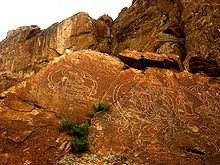
Etymology [edit]
The term stone fine art appears in the published literature equally early every bit the 1940s.[iii] [4] Information technology has as well been described every bit "stone carvings",[5] "stone drawings",[six] "stone engravings",[7] "stone inscriptions",[8] "rock paintings",[9] "rock pictures",[10] "rock records",[eleven] and "rock sculptures.[12] [13]
Background [edit]
Parietal art is a term for art in caves, the definition usually extended to art in rock shelters under cliff overhangs. Popularly, information technology is chosen "cave art", and is a subset of the wider term, rock art. It is generally on rock walls, but may exist on ceilings and floors. A wide diverseness of techniques take been used in its creation. The term usually is applied only to prehistoric art, but it may be used for fine art of any date.[14] Sheltered parietal fine art has had a far better take chances of surviving for very long periods, and what now survives may represent just a very pocket-sized proportion of what was created.[fifteen]
Both parietal and cave art refer to cave paintings, drawings, etchings, carvings, and pecked artwork on the interior of caves and rock shelters. Generally, these either are engraved (substantially significant scratched) or painted, or, they are created using a combination of the 2 techniques.[16] Parietal art is found very widely throughout the globe, and in many places new examples are being discovered.
The defining characteristic of rock art is that it is placed on natural rock surfaces; in this way it is distinct from artworks placed on synthetic walls or costless-standing sculpture.[17] Equally such, stone fine art is a class of landscape art, and includes designs that accept been placed on boulder and cliff faces, cave walls, and ceilings, and on the ground surface.[17] Stone art is a global phenomenon, existence found in many dissimilar regions of the world.[i] In that location are various forms of rock art. Some archaeologists too consider pits and grooves in the rock known equally cupules, or cups or rings, as a form of rock fine art.[17]
Although there are exceptions, the majority of rock art whose creation was recorded by ethnographers had been produced during rituals.[17] As such, the study of rock art is a component of the archaeology of religion.[xviii]
Rock art serves multiple purposes in the gimmicky world. In several regions, it remains spiritually of import to indigenous peoples, who view information technology equally a significant component of their cultural heritage.[ane] It also serves as an important source of cultural tourism, and hence as economical acquirement in certain parts of the world. Equally such, images taken from cave art have appeared on memorabilia and other artefacts sold equally a function of the tourist industry.[2]
Types [edit]

Paintings [edit]
In most climates, but paintings in sheltered site, in detail caves, take survived for any length of fourth dimension. Therefore, these are usually called "cavern paintings", although many do survive in "rock-shelters" or cliff-faces under an overhang. In prehistoric times these were ofttimes popular places for various human being purposes, providing some shelter from the atmospheric condition, besides every bit light. There may take been many more than paintings in more exposed sites, that are at present lost. Pictographs are paintings or drawings that accept been placed onto the stone face up. Such artworks have typically been made with mineral earths and other natural compounds found across much of the world. The predominantly used colours are scarlet, black and white. Cherry paint is usually attained through the use of ground ochre, while blackness pigment is typically equanimous of charcoal, or sometimes from minerals such as manganese. White paint is usually created from natural chalk, kaolinite clay or diatomaceous earth.[19] Once the pigments had been obtained, they would exist footing and mixed with a liquid, such as water, blood, urine, or egg yolk, and then practical to the stone as pigment using a brush, fingers, or a postage stamp. Alternately, the paint could take been applied on dry out, such every bit with a stick of charcoal.[20] In some societies, the pigment itself has symbolic and religious meaning; for instance, among hunter-gatherer groups in California, paint was merely allowed to be traded by the group shamans, while in other parts of North America, the word for "paint" was the same equally the word for "supernatural spirit".[21]
One mutual class of pictograph, found in many, although not all rock-art producing cultures, is the paw print. At that place are iii forms of this; the starting time involves covering the manus in wet paint then applying it to the rock. The 2nd involves a pattern existence painted onto the hand, which is so in plow added to the surface. The tertiary involves the hand first being placed against the console, with dry paint and then existence blown onto it through a tube, in a procedure that is akin to air-castor or spray-painting. The resulting prototype is a negative impress of the manus, and is sometimes described as a "stencil" in Australian archeology.[22] Miniature stencilled art has been found at two locations in Australia and 1 in Republic of indonesia.
Petroglyphs [edit]

Bidzar Petroglyphs in Republic of cameroon
Petroglyphs are engravings or carvings into rock which is left in situ. They tin be created with a range of scratching, engraving or carving techniques, oftentimes with the apply of a hard hammerstone, which is battered against the stone surface. In certain societies, the option of hammerstone itself has religious significance.[23] In other instances, the stone fine art is pecked out through indirect percussion, equally a second rock is used similar a chisel between the hammerstone and the panel.[23] A third, rarer form of engraving rock art was through incision, or scratching, into the surface of the stone with a lithic bit or metallic bract. The motifs produced using this technique are fine-lined and often difficult to see.[24]
Rock reliefs [edit]
Ordinarily found in literate cultures, a rock relief or rock-cut relief is a relief sculpture carved on solid or "living stone" such equally a cliff, rather than a detached piece of stone. They are a category of rock art, and sometimes found in conjunction with stone-cut architecture.[25] Nonetheless, they tend to exist omitted in most works on rock fine art, which concentrate on engravings and paintings by prehistoric peoples. A few such works exploit the natural contours of the stone and utilize them to define an epitome, but they do not amount to man-made reliefs. Stone reliefs have been made in many cultures, and were especially important in the art of the Ancient Near East.[26] Rock reliefs are generally fairly large, as they demand to be to make an impact in the open air. Most accept figures that are over life-size, and in many the figures are multiples of life-size.
Stylistically they commonly relate to other types of sculpture from the culture and period concerned, and except for Hittite and Persian examples they are generally discussed as role of that wider subject.[27] The vertical relief is near common, only reliefs on essentially horizontal surfaces are also found. The term typically excludes relief carvings inside caves, whether natural or themselves man-made, which are especially plant in Republic of india. Natural stone formations fabricated into statues or other sculpture in the round, well-nigh famously at the Dandy Sphinx of Giza, are also usually excluded. Reliefs on big boulders left in their natural location, like the Hittite İmamkullu relief, are likely to be included, merely smaller boulders may be chosen stelae or carved orthostats.
World figures [edit]
Earth figures are large designs and motifs that are created on the stone footing surface. They tin can be classified through their method of industry.[28] Intaglios are created past scraping away the desert pavements (pebbles covering the basis) to reveal a negative image on the bedrock below. The best known example of such intaglio rock art is the Nazca Lines of Peru.[28] In contrast, geoglyphs are positive images, which are created by piling up rocks on the basis surface to resulting in a visible motif or blueprint.[28]
Motifs and panels [edit]
Traditionally, individual markings are called motifs and groups of motifs are known as panels. Sequences of panels are treated as archaeological sites. This method of classifying rock art however has become less popular as the structure imposed is unlikely to accept had any relevance to the art'due south creators. Fifty-fifty the word 'art' carries with information technology many modern prejudices virtually the purpose of the features.[ citation needed ]
Rock fine art can be found across a wide geographical and temporal spread of cultures perhaps to mark territory, to record historical events or stories or to help enact rituals. Some fine art seems to draw real events whilst many other examples are apparently entirely abstract.[ commendation needed ]
Prehistoric rock depictions were non purely descriptive. Each motif and design had a "deep significance" that is not e'er understandable to modern scholars.[29]
Interpretation and use [edit]
Religious interpretations [edit]
In many instances, the cosmos of rock art was itself a ritual deed.[24]
Regional variations [edit]
Europe [edit]
In the Upper Palaeolithic of Europe, stone art was produced inside cavern systems by the hunter-gatherer peoples who inhabited the continent. The oldest known example is the Chauvet Cave in France, although others take been located, including Lascaux in France, Alta Mira in Spain and Creswell Crags in U.k. and Grotta del Genovese in Sicily.
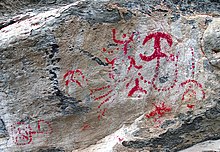
Balma dei Cervi post-palaeolithic rock paintings (Italian western Alps): antropomorphic figures and dottings (DStretch enhanced)
The late prehistoric rock art of Europe has been divided into three regions by archaeologists. In Atlantic Europe, the coastal seaboard on the west of the continent, which stretches from Iberia up through France and encompasses the British Isles, a variety of different rock arts were produced from the Neolithic through to the Late Statuary Age. A second area of the continent to contain a significant rock art tradition was that of Tall Europe, with the majority of artworks existence amassed in the southern slopes of the mountainous region, in what is now s-eastern France and northern Italy.
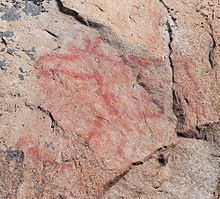
- Finnish Rock Art
- Knowth
- Loughcrew
- Newgrange
- Neolithic and Bronze Age rock fine art in the British Isles
- Stone Drawings in Valcamonica (World Heritage Site)
- Balma dei Cervi at Crodo (Piedmont - Italian Alps)
- Grotta dei Cervi at Porto Badisco (Apulia - Italy)
- Grotta del Genovese (Sicily)
- List of rock carvings in Norway
- Rock carvings at Alta (World Heritage Site)
- Madara Rider (World Heritage Site)
- Côa Valley Paleolithic Fine art (World Heritage Site)
- Cave of Altamira and Paleolithic Cave Art of Northern Spain (World Heritage Site)
- Stone art of the Iberian Mediterranean Basin (World Heritage Site)
- Tanum (Globe Heritage Site)
- Tanums hällristningsmuseum,[30] Rock Art Research Centre and World Heritage Archive, situated in Tanum, Sweden.
Africa [edit]


Long-horned cattle and other rock art in the Laas Geel complex
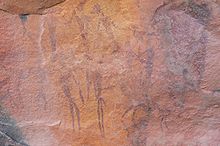

North Africa [edit]
- Southward Oran in Algeria.
- Saharan rock art
- Tadrart Acacus in Great socialist people's libyan arab jamahiriya – World Heritage Site.
- Tassili n'Ajjer in Algeria – national park and World Heritage Site, known for its x,000-twelvemonth-old paintings.
- Cavern of Swimmers is a cave in southwest Egypt, near the border with Libya, forth the western edge of the Gilf Kebir plateau in the primal Libyan Desert (Eastern Sahara). It was discovered in October 1933 past the Hungarian explorer László Almásy. The site contains rock paintings of human figures who announced to be swimming, which have been estimated to have been created at least 6,000 to 7000 years ago. The Cavern of Beasts 10 km westwards was discovered in 2002.
- Jebel Uweinat, a large granite and sandstone mountain, as well as the side by side smaller massifs of Jebel Arkenu and Jebel Kissu at the converging triple borders of Libya, Egypt and Sudan, harbors 1 of the richest concentrations of prehistoric rock art in the entire Sahara. The rock art here mainly consists of the Neolithic cattle pastoralist cultures, simply also a number of older paintings from hunter-gatherer societies.
- Sabu-Jaddi rock fine art site in Northern Sudan.
- Northward Sİnai Archaeological Sites Zone − World Heritage Site.[31] Limestone cavern decorated with scenes of animals such as donkeys, camels, deer, mule and mount goats was uncovered in the site in 2020. Rock art cavern is fifteen meters deep and twenty meters high.[32]
- Wadi Abu Dom
Western Africa [edit]
- Boucle du Baoulé National Park
- Dabous Giraffes
Eastward Africa [edit]
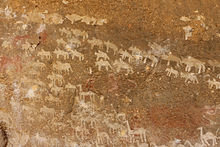
Stone art in the Adi Alauti cave, Eritrea
- Qohaito in Eritrea – vii,000 years old stone art well-nigh the aboriginal city Qohaito.
- Dorra and Balho in Republic of djibouti – Stone art sites with figures of what announced to be antelopes and a giraffe.
- Kundudo in Ethiopia – Flat tiptop mountain complex with stone fine art in a cave.
- Laas Geel in Somalia – A number of cave paintings and petroglyphs tin exist establish at diverse sites across the state. Among the most prominent examples of this is the rock art in Laas Geel, Dhambalin, Gaanlibah and Karinhegane.
- Nyero Rockpaintings, Uganda-World Heritage Site, pre-historic paintings was noticed before 1250 AD[33]
- Swaga Swaga Game Reserve in Tanzania – Archaeologists appear the discovery of ancient rock art with anthropomorphic figures in a good condition at the Amak'hee iv rockshelter site. Paintings made with a reddish dye also independent buffalo heads, giraffe's head and neck, domesticated cattle dated back to about several hundred years ago.[34] [35]
- Bahi rock paintings
- Chabbé
- Dhaymoole
- Handoga
- Kondoa Rock-Art Sites
- Mfangano Isle
- Rock art of Republic of uganda
Southern Africa [edit]
Cavern paintings are establish in virtually parts of Southern Africa that have rock overhangs with smoothen surfaces. Amid these sites are the cave sandstone of Natal, Orange Gratuitous Country and Due north-Eastern Cape, the granite and Waterberg sandstone of the Northern Transvaal, and the Tabular array Mount sandstone of the Southern and Western Cape.[36]
- UKhahlamba Drakensberg Park in South Africa – The site has paintings dated to around 3,000 years old and which are thought to have been drawn by the San people and Khoisan people, who settled in the area some viii,000 years ago. The stone art depicts animals and humans and is thought to stand for religious behavior.
- Tsodilo Hills in Botswana – A World Heritage Site with rock art
- Brandberg Mount (Daureb) in Namibia – It is one of the most of import rock art localities on the African continent. Most visitors but meet "The White Lady" shelter (which is neither white, nor a lady, the famous scene probably depicts a young male child in an initiation ceremony), all the same the upper reaches of the mount is full of sites with prehistoric paintings, some of which rank among the finest artistic achievements of prehistory.
- Bambata Cavern, Zimbabwe- Fauna paintings and human being drawings are supposed to be age from two.000 to 20.000 years erstwhile[37] [38] [39]
- Mwela and Adjacent Areas Rock Art Site, Republic of zambia
- Chongoni Stone Art Area
- Driekops Eiland
- Modderpoort Sacred Sites
- Nooitgedacht Glacial Pavements
- Nyambwezi Falls
- San rock art
- Twyfelfontein
- Wildebeest Kuil Stone Art Centre
The Americas [edit]

The oldest reliably dated rock fine art in the Americas is known as the "Horny Petty Man." It is petroglyph depicting a stick figure with an oversized phallus and carved in Lapa practice Santo, a cave in fundamental-eastern Brazil.[40] The nearly important site is Serra da Capivara National Park at Piauí state. It is a UNESCO World Heritage Site with the largest collection in the American continent and i of the virtually studied.
A site including eight miles of paintings or pictographs that is under study in Colombia, South America at Serranía de la Lindosa was revealed in November 2020.[41] Their age is suggested as being 12,500 years old (c. ten,480 B.C.) by the anthropologists working on the site because of extinct creature depicted.
Rock paintings or pictographs are located in many areas across Canada. In that location are over 400 sites attributed to the Ojibway from northern Saskatchewan to the Ottawa River.[42]
- Pomier Caves, Dominican Commonwealth
- Naj Tunich, Guatemala
- Stone Paintings of Sierra de San Francisco, Baja California, Mexico
- Sierra de Guadalupe cave paintings, Baja California, United mexican states
- Pictograph Cave Circuitous, Billings, Montana, Usa
- Cañon Pintado, Colorado, United states of america
- Chaco Civilization National Historical Park, New Mexico, United States
- Chumash stone art, California, The states
- Coso Rock Art District, California, United states of america
- Nine Mile Canyon, Utah, United States
- Quail stone art panel, Utah, United States
- Painted Rocks, Arizona, United States
- Petroglyph National Monument, New Mexico, The states
- Serra da Capivara National Park, Piauí, Brazil
- Vale practice Catimbau National Park, Pernambuco, Brazil.
- Localidad Rupestre de Chamangá, Uruguay
- Writing-on-Rock Provincial Park, Alberta, Canada
- Cueva de las Manos, Santa Cruz Province, Argentina
- Huerfano Butte, Arizona, The states
- Petroglyphs Provincial Park, Ontario, Canada
- Serranía La Lindosa, Guaviare Department, Colombia[43] [41]
Asia [edit]



Petroglyphs in Gobustan, Azerbaijan, dating dorsum to ten,000 BC.
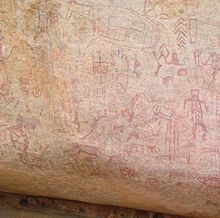
Rock art in Balichakra near Yadgir boondocks in Karnataka, India
Cardinal Asia [edit]
- Gobustan National Park in Republic of azerbaijan
- Petroglyphs of Arpa-Uzen, Republic of kazakhstan
- Siypantosh Rock Paintings in Uzbekistan
- Zarautsoy Rock Paintings in Uzbekistan
East Asia [edit]
- Bangudae Petroglyphs, in Due south Korea
- Cheonjeon-ri in South Korea[44]
- Daegok-ri in Due south Korea[44]
- Fugoppe Cavern petroglyphs on Hokkaido, Japan[44]
- Helankou in Yinchuan, Prc[44]
- Kangjia shimenzi in Xinjiang, China[44]
- Oponoho (Wanshan) petroglpyhs in Taiwan[44]
- Temiya Cave on Hokkaido, Japan[44]
- Yinshan petroglyphs in the Yin Mountains, People's republic of china
- Zuo River Huashan rock art in Guangxi, People's republic of china[44]
- Above 4000 meters to a higher place bounding main level high Tibetan plateau: peradventure the oldest rock art, likely dating dorsum to ∼169–226,000 years agone, much older than what was previously thought to exist the primeval known drawing, fabricated ~73,000[45] years agone. According to the study, children likely intentionally placed a series of hands and feet in mud. The findings could also be the primeval bear witness of Hominins on the loftier Tibetan plateau.[46] [47] [48]
Southeast Asia [edit]
- Angono Petroglyphs, the Philippines
- Bir Hima Stone Petroglyphs and Inscriptions
- Pettakere cave, Southward Sulawesi, Indonesia – hand print paintings
- Pha Taem in Thailand
- Tambun rock art, Malaysia
Southern asia [edit]
- Bhimbetka rock shelters (World Heritage Site), Madhya Pradesh, India with rock art ranging from the Mesolithic (c.8,000 BC) to historical times[49] [50] [51] [52] [53] [54]
- Edakkal Caves, Kerala India
- Gavali, Udupi
- Hire Benakal, Karnataka
- Balichakra, Yadgir town in Karnataka, India
- Rock paintings of Tamil Nadu, in India (several sites)[55]
- Kaimur district, Bihar, India (several sites)
- Rock paintings of Andhra Pradesh, in India (several sites)[55]
- Sonda, Karnataka
Western Asia [edit]
- Rock Art in the Ha'il Region in Saudi Arabia
- Iranian rock art sites are mostly institute in the Zagros Mountain range. Merely in that location are many other sites in Central Iran, Sistan and Baluchistan, and Azarbaijan. Virtually of these rock arts engagement back to the late prehistory and age. Among which the well-known sites of Houmian at Kuhdasht,[56] Khomein, and Teimareh[57] in Cardinal Islamic republic of iran are outstanding.
- Large carvings of camels that were discovered in 2018 in Saudi Arabia are estimated to exist 7,000 to viii,000 years onetime.[58] This Neolithic dating would make the carvings significantly older than Stonehenge (5,000 years old) and the Egyptian pyramids at Giza (4,500 years sometime).
Australasia [edit]
Australia [edit]
Australian Indigenous art represents the oldest unbroken tradition of fine art in the earth. There are more than than 100,000 recorded rock fine art sites in Australia.[59]
The oldest firmly dated rock-art painting in Commonwealth of australia is a charcoal drawing on a rock fragment found during the excavation of the Nawarla Gabarnmang rock shelter in due south western Arnhem Country in the Northern Territory. Dated at 28,000 years, it is ane of the oldest known pieces of rock art on Globe with a confirmed date. Nawarla Gabarnmang is considered[ past whom? ] to have one of the about extensive collections of rock art in the world and predates both Lascaux and Chauvet cavern fine art - the earliest known art in Europe - by at least 10,000 years.[60] [61]
In 2008 rock art depicting what is thought to be a Thylacoleo was discovered[ by whom? ] on the north-western declension of the Kimberley.[62] As the Thylacoleo is believed to have get extinct 45000–46000 years agone (Roberts et al. 2001) (Gillespie 2004), this suggests a like age for the associated Gwion Gwion rock paintings. Archaeologist Kim Akerman notwithstanding believes that the megafauna may have persisted after in refugia (wetter areas of the continent) every bit suggested by Wells (1985: 228) and has suggested a much younger age for the paintings.[62] Pigments from the Gwion Gwion of the Kimberley are so former they have get part of the rock itself, making carbon dating impossible. Some experts suggest that these paintings are in the vicinity of fifty,000 years old and may even pre-date Aboriginal settlement.[63] [64]
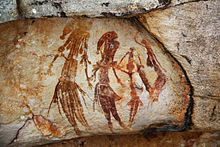
Miniature rock art of the stencilled diverseness at a rock shelter known as Yilbilinji, in the Limmen National Park in the Northern Territory, is one of only three known examples of such fine art. Unremarkably stencilled fine art is life-size, using body parts as the stencil, but the 17 images of designs of homo figures, boomerangs, animals such as crabs and long-necked turtles, wavy lines and geometric shapes are very rare. Institute in 2017 by archaeologists, the merely other recorded examples are at Nielson's Creek in New Due south Wales and at Kisar Island in Republic of indonesia. Information technology is idea that the designs may take been created past stencils fashioned out of beeswax.[65] [66] [67]
- Kakadu National Park in the Northern Territory has a large collection of ochre paintings. Ochre is a not an organic cloth, so carbon dating of these pictures is incommunicable. Sometimes the gauge appointment, or at to the lowest degree an epoch, tin be guessed from the content.
- The Sydney region has important rock engravings.
- Mount Grenfell Celebrated Site near Cobar, western New Due south Wales has important aboriginal stone-drawings.
- The Murujuga (Burrup Peninsula) expanse of Western Australia near Karratha is estimated[ by whom? ] to exist abode to between 500,000 and 1 million individual engravings.
- Kimberley region of Western Australia. Apprentice archaeologist Grahame Walsh, who researched Gwion Gwion rock paintings in the region from 1977 until his decease in 2007, produced a photographic database of 1.5 meg Gwion Gwion rock paintings.[68] Many of the Gwion rock paintings maintain vivid colours considering they take been colonised by bacteria and fungi, such as the black fungus, Chaetothyriales. The pigments originally applied may accept initiated an ongoing, symbiotic human relationship between blackness fungi and red bacteria.[69]
- The Grampians-Gariwerd region is Victoria is one of the richest Aboriginal rock fine art sites in south-eastern Australia.[70] Some of the more well-known and easily accessible sites are the Ngamadjidj Shelter (Cave of Ghosts), Gulgurn Manja (Flat Rock), Billimina (Glenisla Shelter) and Manja (Cave of Hands);[71] one of the most significant sites in south-eastern Australia is Bunjil'due south Shelter, near Stawell,[72] which is the only known rock art depiction of Bunjil, the creator-beingness in Ancient Australian mythology.[73]
- The Maliwawa Figures in Arnhem Land, a series of 571 paintings and a drawing, created between 6,000 and 9,400 years ago, show a way nor recognised by researchers in the field before new research was done in 2016–2018 and published in September 2020 by Paul Taçon and his team.[74] [75]
- The Turramurra site in western Queensland is opening in 2020. Cliffs on the belongings, for some time known equally Grace Vale Station, are covered with ancient rock art, including paintings and etchings of megafauna, emu symbols and the traditional songline of the 7 Sisters. Planning for an educational heart created from local stone is under way.[76]
New Zealand [edit]
In New Zealand, North Otago and Due south Canterbury accept a rich range of early Māori rock fine art.[77]
- The Takiroa Stone Art Shelter near Duntroon contains Māori artwork made from ochre and charcoal.[78]
Studies [edit]
The archaeological sub-field of study devoted to the investigation of stone fine art is known every bit "stone fine art studies." Rock art specialist David Southward. Whitley noted that research in this area required an "integrated effort" that brings together archaeological theory, method, fieldwork, belittling techniques and estimation.[79]
History [edit]
Although French archaeologists had undertaken much research into rock art, Anglophone archaeology had largely neglected the subject for decades.[fourscore]
The subject of rock fine art studies witnessed what Whitley called a "revolution" during the 1980s and 1990s, as increasing numbers of archaeologists in the Anglophone earth and Latin America turned their attending to the subject area.[81] In doing then, they recognised that rock art could be used to understand symbolic and religious systems, gender relations, cultural boundaries, cultural change and the origins of art and belief.[1] Ane of the nigh significant figures in this movement was the South African archeologist David Lewis-Williams, who published his studies of San rock art from southern Africa, in which he combined ethnographic data to reveal the original purpose of the artworks. Lewis-Williams would come to be praised for elevating stone art studies to a "theoretically sophisticated research domain" by Whitley.[82] However, the study of rock art worldwide is marked by considerable differences of stance with respect to the appropriateness of diverse methods and the most relevant and defensible theoretical framework.
International databases and archives [edit]
The UNESCO World Rock Art Archive Working Grouping met in 2011 to talk over the base model for a World Stone Art Annal.[83] While no official output has been generated to date various projects around the globe, such as for example The Global Rock Art Database,[84] [85] are looking at making rock fine art heritage information more accessible and more visible to assist with rock fine art awareness, conservation and preservation issues.
Come across also [edit]
- List of Stone Age art
- The Kindness Rock Projection
Notes [edit]
- ^ a b c d Whitley 2005, p. 1.
- ^ a b Whitley 2005, pp. 1–2.
- ^ Due east. Goodall, Proceedings and Transactions of the Rhodesian Scientific Clan 41:57-62, 1946: "Domestic Animals in rock art"
- ^ E. Goodall, Proceedings and Transactions of the Rhodesian Scientific Association 42:69-74, 1949: "Notes on sure human representations in Rhodesian stone art"
- ^ H. Grand. Chadwick, Origin Eng. Nation xii. 306, 1907: "The rock-carvings at Tegneby"
- ^ H. A. Winkler, Rock-Drawings of Southern Upper Egypt I. 26, 1938: "The discovery of rock-drawings showing boats of a type foreign to Egypt."
- ^ H. Grand. Wells, Outl. Hist. I. xvii. 126/1, 1920: From rock engravings we may deduce the theory that the desert was crossed from haven to haven.
- ^ Deutsch, Rem. 177, 1874: "The long rock-inscription of Hamamât."
- ^ Encycl. Relig. & Ideals I. 822/2, 1908: "The stone-paintings are either stenciled or painted in outline."
- ^ Man No. 119. 178/2, 1939: "On one of the stalactite pillars was found a big round stone with traces of red paint on its surface, as used in the rock-pictures"
- ^ One thousand. Moore, The Lost Tribes and the Saxons of the East, 1861, Title page: "with translations of Rock-Records in Bharat."
- ^ Tylor, Early Hist. Man. 5. 88, 1865, "and bush art or bushmen art."
- ^ Trust For African Rock Art, East Africa, common terminology, "Rock-sculptures may often exist symbolic purlieus marks."
- ^ Bahn, 99-101
- ^ Bahn, 101
- ^ Bahn, 101-105
- ^ a b c d Whitley 2005, p. three.
- ^ Whitley 2005. pp. 3–4.
- ^ Whitley 2005, p. 4.
- ^ Whitley 2005, pp. 4–5.
- ^ Whitley 2005, p. 9.
- ^ Whitley 2005, pp. 7–9.
- ^ a b Whitley 2005, p. 11.
- ^ a b Whitley 2005, p. xiii.
- ^ Harmanşah (2014), 5–6
- ^ Harmanşah (2014), v–six; Canepa, 53
- ^ for example by Rawson and Sickman & Soper
- ^ a b c Whitley 2005, p. 14.
- ^ Arca 2004, p. 319.
- ^ "Scandinavian Society for Prehistoric Art". world wide web.rockartscandinavia.se. Archived from the original on 2013-x-25. Retrieved 2022-03-01 .
- ^ Centre, UNESCO World Heritage. "North Sinai archaeological Sites Zone". UNESCO World Heritage Centre . Retrieved 2020-09-09 .
- ^ "Ancient cave with distinguished engravings depicting scenes of animals discovered in Sinai - Ancient Egypt - Heritage". Ahram Online . Retrieved 2020-09-09 .
- ^ "NYERO & OTHER ROCK ARTSITES IN EASTERN Republic of uganda" (PDF).
- ^ "Tanzanian Rock Art Depicts Trios of Bizarre Anthropomorphic Figures | Archæology | Sci-News.com". Breaking Science News | Sci-News.com . Retrieved 2021-02-16 .
- ^ "Mysterious and bizarre: scientists discovered ancient rock art that dates back to several hundred years agone". www.msn.com . Retrieved 2021-02-16 .
- ^ Standard Encyclopaedia of Southern Africa (1973)
- ^ "Rock Age - Africa". Encyclopedia Britannica . Retrieved 2018-10-twenty .
- ^ "Big Cave Camp | Famous Rock Art Galleries - visits to Nswatugi cave, Bambata, Silozwane cave, Inanke cavern and Maholoholo cave". Big Cavern . Retrieved 2018-10-xx .
- ^ https://austria-forum.org/, Austria-Forum |. "Rock Paintings Bambata Cave (1)". Global-Geography . Retrieved 2018-10-twenty .
- ^ Choi, Charles. "Telephone call this ancient rock etching 'footling horny man'." Science on NBC News. 22 Feb 2012. Retrieved 9 April 2012.
- ^ a b Alberge, Dalya, 'Sistine Chapel of the ancients' rock art discovered in remote Amazon forest, The Guardian, Dominicus, November 29, 2020
- ^ Grace Rajnovich. (1994) Reading rock art: interpreting the Indian stone paintings of the Canadian Shield. Toronto:Natural Heritage/Natural History Inc.
- ^ "Research news - Newly discovered Amazon rock art evidence the rainforest's primeval inhabitants living with giant Ice Age animals - University of Exeter". 2020-12-01. Archived from the original on 2020-12-01. Retrieved 2020-12-01 .
- ^ a b c d e f g h O'Sullivan, Rebecca (2018). "Eastern asia: Rock Art". Encyclopedia of Global Archaeology (2 ed.). Springer. pp. 1–11. doi:10.1007/978-iii-319-51726-1_3131-1. ISBN978-3-319-51726-i.
- ^ Henshilwood, Christopher Due south.; d'Errico, Francesco; van Niekerk, Karen L.; Dayet, Laure; Queffelec, Alain; Pollarolo, Luca (Oct 2018). "An abstruse drawing from the 73,000-year-old levels at Blombos Cavern, South Africa" (PDF). Nature. 562 (7725): 115–118. doi:ten.1038/s41586-018-0514-3. ISSN 1476-4687. PMID 30209394. S2CID 52197496.
- ^ Lanese, Nicoletta. "Kids' Fossilized Handprints May Exist Some of the Earth's Oldest Art". Scientific American . Retrieved 17 October 2021.
- ^ Davis-Marks, Isis; Davis-Marks, Isis. "These 200,000-Year-Old Hand and Footprints Could Exist the Earth'due south Primeval Cave Art". Smithsonian Magazine . Retrieved 17 October 2021.
- ^ Zhang, David D.; Bennett, Matthew R.; Cheng, Hai; Wang, Leibin; Zhang, Haiwei; Reynolds, Sally C.; Zhang, Shengda; Wang, Xiaoqing; Li, Teng; Urban, Tommy; Pei, Qing; Wu, Zhifeng; Zhang, Pu; Liu, Chunru; Wang, Yafeng; Wang, Cong; Zhang, Dongju; Lawrence Edwards, R. (ten September 2021). "Earliest parietal art: Hominin hand and pes traces from the center Pleistocene of Tibet". Science Message. doi:10.1016/j.scib.2021.09.001. ISSN 2095-9273. S2CID 239102132.
- ^ "Rock Shelters of Bhimbetka". World Heritage Site. Retrieved 2007-02-xv .
- ^ Mathpal, Yashodhar (1984). Prehistoric Painting Of Bhimbetka. Abhinav Publications. p. 220. ISBN9788170171935.
- ^ Tiwari, Shiv Kumar (2000). Riddles of Indian Rockshelter Paintings. Sarup & Sons. p. 189. ISBN9788176250863.
- ^ Stone Shelters of Bhimbetka (PDF). UNESCO. 2003. p. 16.
- ^ Mithen, Steven (2011). After the Ice: A Global Human being History, 20,000 - 5000 BC. Orion. p. 524. ISBN9781780222592.
- ^ Javid, Ali; Jāvīd, ʻAlī; Javeed, Tabassum (2008). World Heritage Monuments and Related Edifices in Republic of india. Algora Publishing. p. 19. ISBN9780875864846.
- ^ a b "Chapter -ane Introduction to Rock Art in India" (PDF). [ expressionless link ]
- ^ Bewley, R. H. (1984). "The Cambridge University Archaeological Trek To Iran 1969. Excavations in Zagros Mountains : Homian, Mir Malas, Barde Spid". Iran. 22: 1. doi:10.2307/4299734. JSTOR 4299734.
- ^ Farhadi, M (1999). Museums in wind. Tehran: Allameh Tabataba'i University Press.
- ^ Saudi Arabia camel carvings dated to prehistoric era, BBC, September 15, 2021
- ^ Griffiths, Billy (2018). Deep Time Dreaming: Uncovering Aboriginal Australia. Blackness Inc. p. 176.
- ^ Barker, Bryce (18 June 2012). "Australia'south oldest rock art discovered by USQ researcher". University of Southern Queensland. Archived from the original on 1 February 2014. Retrieved xx January 2014.
- ^ Collis, Clarisa (June 2012). "Aboriginal artists of rock and soul". Monash University . Retrieved xx January 2014.
- ^ a b Akerman, Kim; Willing, Tim (March 2009). "An ancient rock painting of a marsupial lion, Thylacoleo carnifex, from the Kimberley, Western Commonwealth of australia". Antiquity . Retrieved 11 December 2012.
- ^ "The Times Literary Supplement – TLS". timesonline.co.uk.
- ^ Bradshaw Foundation. "The Bradshaw Paintings – Australian Rock Art Annal". Bradshaw Foundation.
- ^ Zwartz, Henry (27 May 2020). "Ethnic rock art found in the NT one of just iii such examples worldwide". ABC News (Australian Broadcasting Corporation) . Retrieved 28 May 2020.
- ^ Flinders University (26 May 2020). "Miniature rock art expands horizons". Phys.org . Retrieved 28 May 2020.
- ^ "Archaeologists reveal stone fine art's large little secret". Flinders University (News). 27 May 2020. Retrieved 28 May 2020.
- ^ "Rock Heart – Australian Story". abc.net.au. 15 October 2002.
- ^ "Ancient stone fine art's colours come from microbes". BBC News. 27 December 2010.
- ^ "National Heritage Places - Grampians National Park (Gariwerd)". Department of Agriculture, Water and the Surround. Australian Authorities. Retrieved eight July 2020.
- ^ "Aboriginal Rock Art Sites" (PDF). Brambuk . Retrieved 8 July 2020.
- ^ "Ancient Victoria, Grampians, Victoria, Australia". Visit Victoria. 5 October 2016. Retrieved 8 July 2020.
- ^ "Bunjil Shelter - Stawell, Allure, Grampians, Victoria, Australia". Visit Victoria. 30 March 2020. Retrieved eight July 2020.
- ^ Taçon, Paul South. C.; May, Emerge Yard.; et al. (thirty September 2020). "Maliwawa figures—a previously undescribed Arnhem Fifty and rock art way". Australian Archaeology. Informa United kingdom of great britain and northern ireland Limited. 86 (3): 208–225. doi:x.1080/03122417.2020.1818361. ISSN 0312-2417. S2CID 224849841 – via Taylor & Francis Online.
- ^ Weule, Genelle (1 October 2020). "'Bilbies', thylacines and dugongs among stunning Maliwawa rock art documented in Arnhem Land". ABC News. ABC Science. Australian Broadcasting Corporation. Retrieved 3 October 2020.
- ^ Larkins, Damien (17 October 2020). "Ethnic story wall restored, open to visitors in outback Queensland". ABC News. Australian Broadcasting Corporation. Retrieved 21 October 2020.
- ^ Barrow, Terence (1978). Maori art of New Zealand (reprint ed.). Unesco Press. p. 70. ISBN9789231013195 . Retrieved 2018-03-06 .
The Northward Otago and South Canterbury districts of the South Island present a rich range of rock fine art in red and black pigments. The motifs used are mainly humans, monsters, birds, and fish, and are styles which pre-date Classic Maori traditional art.
- ^ McKinnon, Malcolm (29 July 2015). "Otago places - N Otago". Te Ara - the Encyclopedia of New Zealand . Retrieved 30 May 2019.
- ^ Whitley 2005, p. xi.
- ^ Whitley 2005. pp. viii, i.
- ^ Whitley 2005, p. x.
- ^ Whitley 2005, p. viii.
- ^ *UNESCO World Heritage Centre (2011). "Globe Rock Art Archives to meet in Tanum". Retrieved May ane, 2011.
- ^ R., Haubt. "Rock-Art Database". www.rockartdatabase.com.
- ^ Haubt, R.A.; Tacon, P.S.C. (October 22, 2016). "A collaborative, ontological and information visualization model approach in a centralized rock art heritage platform". Journal of Archaeological Science: Reports. 10: 837–846. doi:ten.1016/j.jasrep.2016.x.013.
References [edit]
- Arca, Andrea (2004). "The topographical engravings of Alpine rock-art: fields, settlements and agricultural landscapes". The Figured Landscapes of Stone-Art. Cambridge University Press. pp. 318–349.
- Bahn, Paul (ed), The Cambridge Illustrated History of Prehistoric Fine art, 1998, Cambridge University Press, ISBN 0521454735, 9780521454735, google books
- Devlet, Ekaterina (2001). "Stone Art and the Material Culture of Siberian and Fundamental Asian Shamanism" (PDF). The Archaeology of Shamanism. pp. 43–54. Retrieved Apr 1, 2007.
- Harmanşah, Ömür (ed) (2014), Of Rocks and Water: An Archæology of Identify, 2014, Oxbow Books, ISBN 1782976744, 9781782976745
- Haubt, R.A.; Tacon, P.S.C. (October 22, 2016). "A collaborative, ontological and information visualization model approach in a centralized rock art heritage platform". Periodical of Archaeological Scientific discipline: Reports. 10: 837–846. doi:10.1016/j.jasrep.2016.ten.013.
- Rawson, Jessica (ed). The British Museum Book of Chinese Fine art, 2007 (second edn), British Museum Printing, ISBN 9780714124469
- Schaafsma, Polly, 1980, Indian Rock Art of the Southwest, Schoolhouse of American Research, Santa Fe, University of New United mexican states Press, Albuquerque NM, ISBN 0-8263-0913-5. Scholarly text with 349 references, 32 color plates, 283 black and white "figures", 11 maps, and 2 tables.
- Sickman, Laurence, in: Sickman L., & Soper A., The Art and Architecture of China, Pelican History of Fine art, tertiary ed 1971, Penguin (now Yale History of Art), LOC seventy-125675
- UNESCO World Heritage Centre (2011). "World Rock Art Athenaeum to meet in Tanum". Retrieved May 1, 2011.
- Whitley, David Due south. (2005). Introduction to Rock Art Research. Walnut Creek, California: Left Coast Press. ISBN978-1598740004.
Further reading [edit]
- David, Bruno, Cave Art, 2017, Thames and Hudson, ISBN 9780500204351
- Malotki, Ekkehart and Weaver, Donald E. Jr., 2002, Stone Chisel and Yucca Brush: Colorado Plateau Rock Art, Kiva Publishing Inc., Walnut, California, ISBN 1-885772-27-0 (textile). For the "general public"; this volume has well over 200 colour prints with commentary on each site where the photos were taken; the organization begins with the earliest fine art and goes to modern times.
- B. B. Lal (1968). Indian Rock Paintings: Their Chronology, Technique and Preservation.
- Rohn, Arthur H. and Ferguson, William M, 2006, Puebloan Ruins of the Southwest, University of New Mexico Press, Albuquerque NM, ISBN 0-8263-3970-0 (pbk, : alk. paper). Adjunct to the chief discussion of the ruins, contains color prints of stone art at the sites, plus interpretations.
- Zboray, András, 2005, Rock Fine art of the Libyan Desert, Fliegel Jezerniczky, Newbury, Great britain (1st Edition 2005, 2nd expanded edition 2009). An illustrated catalogue and bibliography of all known prehistoric rock art sites in the central Libyan Desert (Arkenu, Uweinat and the Gilf Kebir plateau). The second edition contains more than that 20000 photographs documenting the sites. Published on DVD-ROM.
External links [edit]
- IFRAO International Federation of Rock Art Organizations, comprising sixty bookish stone art organizations of the globe. Some of these are:
- ARARA American Stone Art Research Association.
- ANISA Anisa, Verein für Alpine Forschung.
- AURA Australian Stone Art Research Association, Inc.
- CARA Cave Art Enquiry Association.
- IC Institutum Canarium.
- CeSMAP Centro Studi due east Museo d'Arte Preistorica.
- CCSP Centro Camuno practise Studi Preistorici.
- SCAO Società Cooperativa Archeologica Le Orme dell'Uomo.
- AARS Association des Amis de 50'art Rupestre Saharien.
- SIARB Bolivian Rock Art Research Society.
- ANAR Archivo Nacional de Arte Rupestre (Venezuela).
- APAR Asociación Peruana de Arte Rupestre.
- AAV Asociación Arqueológica Viguesa.
- AEARC Asociación de Estudios del Arte Rupestre de Cochabamba.
- ABAR Associação Brasileira de Arte Rupestre.
- ASER Association de Sauvegarde, d'Etude et de Recherche cascade le patrimoine naturel et culturel du Centre-Var.
- ESRARA Eastern States Rock Art Research Association.
- GERSAR Groupe d'Études, de Recherches et de Sauvegarde de l'Fine art Rupestre.
- GCIAR Grupo Cubano de Investigaciones de Arte Rupestre.
- INAAK Instituto de Investigación de Arqueología y Antropología 'Kuelap'.
- NMMZ National Museums and Monuments of Republic of zimbabwe.
- NRAF Nevada Rock Art Foundation.
- NCRAT Northern Cape Stone Art Trust.
- SDRAA San Diego Rock Art Clan.
- TARA The Trust for African Rock Art.
- Bradshaw Foundation Extensive annal on rock art from all effectually the earth.
- Altarockart.no A digital archive of the Rock Art of Alta, Norway
- Global Rock Art Database (RADB) rockartdatabase, Global Stone Art Database (RADB) search tool for international rock art archives
- Maira Valley, Piedmont, Italia Stone Art in Maira Valley, Piedmont, Italia
- Chauvet Cave Database of European Prehistoric Art
- England's Rock Art on the Web Access to the ERA database containing over 1500 records of stone art panels with images and 3D models.
- Tassili North'Ajjer, Rock Art of the central Tassili N'Ajjer (Tamrit, Sefar, Can Tazarift, Jabbaren)
- Uweinat and the Gilf Kebir, Rock Art of Jebel Uweinat and the Gilf Kebir plateau ("Cavern of Swimmers")
- Upper Brandberg, The rock paintings of the Upper Brandberg, Namibia
- Libyan Desert, Stone Art of the Libyan Desert, and illustrated catalogue and bibliography of the prehistoric rock fine art of the primal Libyan Desert
- Rupestreweb.info, Latin American rock art. Articles, Zones, News, Rock art researchers directory
- Tanums Hällristningsmuseum Archived 2013-10-25 at the Wayback Car Rock Art Research Centre and World Heritage Archive, situated in Tanum, Sweden.
- Stone Art Studies (RAS) – A Bibliographic database at the Bancroft Library containing over 18,000 citations to the world's rock art literature.
- Stone Fine art Examples and Epitome Capture – Examples from the Côa Valley in Portugal and Magdalenian Stone Art.
- The Stone Art Foundation – Native American Stone Art in the Lower Pecos region of Southwest Texas
- Beckensall Archive Rock carvings made by Neolithic and Early Bronze Age people in Northumberland in the n e of England, between 6000 and 3500 years ago.
- British Rock Fine art Drove Over xvi.000 photos of more than than 1200 rock art sites in the U.k. with relevant information and links.
- Cleaved Rock Gallery and Petroglyph Designs.
- Rupestre.net A rock art site, mainly devoted to Valcamonica and Alpine Rock Art.
- EuroPreArt The database of European Prehistoric Fine art.
- Rock Fine art of the Murujuga (Burrup Peninsula) Western Australia
- Rock Art in South Africa
- UNESCO World Heritage: Rock Shelters of Bhimbetka
- Bundelkhand Stone Paintings, India
- SpiralZoom.com, an educational website about the science of pattern formation, spirals in nature, spirals in the mythic imagination & screw rock art
- Worldwide Rock Art Selection
- Prehistoric Rock Fine art in Iran
- Petroglyphs in Islamic republic of iran (In Persian)
- Sydney Rock Art
- Rock Art in Oregon
- Rock Art Inquiry Institute, University of Witwatersrand, Johannesburg, S Africa.
- Rock Fine art of the Lower Pecos, Texas Archive of the Moving Image
Source: https://en.wikipedia.org/wiki/Rock_art
0 Response to "All the Rock Art in Africa That Is Possible to Find Has Been Found True False"
Post a Comment